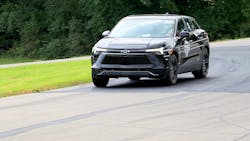Paving the Way: 2024 Model Year Mich. State Police Vehicle Evaluations
During the Michigan State Police Precision Driving Unit’s annual Vehicle Evaluations this past fall, law enforcement patrol vehicles continued down the path of becoming both larger and more energy efficient, while the drivers performing the tests were pleased with the consistent results shown from the models submitted from the Big Three automakers: General Motors, Ford and Stellantis.
This article appeared in the November/December issue of OFFICER Magazine. Click Here to subscribe to OFFICER Magazine.
This year, 12 patrol vehicles were tested as part of the 2024 Model Year evaluations. All of the models were tested with a clean roof—no overhead light or light bar—and were equipped with tires that are available as original equipment on the production model. The vehicle dynamics testing was performed at the Grattan Raceway’s two-mile road course, while the acceleration, top speed and braking tests were performed at the Chelsea Proving Grounds, home of Stellantis, which submitted two Dodge Durango models for testing. This was the first year the automaker chose not to submit a new model of the Dodge Charger, which was the last remaining sedan for law enforcement on the market being tested by the Michigan State Police. A new addition to the fleet tested this year was the Chevrolet Blazer EV. It marks the second electric vehicle to be submitted for testing after the Ford Mustang Mach-E was first entered two years ago.
Lt. Nicholas Darlington, who oversaw the vehicle evaluations for the first time after taking the reins of the Precision Driving Unit from Lt. Mike McCarthy, who retired last year, spoke to OFFICER Magazine about the crop of vehicles that was put to the test, and how he thinks patrol vehicles will continue to evolve in the future.
The new standard
Of the 12 models submitted for testing this year, seven were SUVs, including versions of the Chevrolet Tahoe, Dodge Durango and the Ford Police Interceptor Utility; three were pickup trucks, including versions of the Chevrolet Silverado and the Ford F-150 Police Responder; and the two crossover EVs submitted this year from General Motors and Ford.
The Ford Mustang Mach-E AWD was the smallest model of the submitted and the only compact crossover but is still larger than the sedans built for law enforcement in the past. The move from sedans to SUVs, and even pickup trucks, has been years in the making. Officers need more space to carry their ever-growing assortment of gear, while agencies need ample room inside the vehicles to house electronics and hardware to support the technology supporting its officers.
Last year, General Motors Fleet submitted the Chevrolet Silverado 27X 4WD and the Chevrolet Silverado Z71 4WD Chevrolet Blazer EV AWD Michigan State Police for the first time, one year after Ford Pro submitted the Ford F-150 Police Responder 3.5L EcoBoost. The switch to pursuit-capable pickup trucks was surprising to some at the time, but Darlington says that all of the models stack up well to their SUV counterparts.
When it came to the pickup trucks, he says that all of the models performed very well in the tests. “I think what’s really remarkable is if you look at the test results in comparison to each other, they’re very comparable. The manufacturers can design not only an SUV, but a pickup truck to be able to perform the way it does. I think it’s great for police agencies as a whole because it gives us a variety of vehicles to choose from to meet the specific application we’re looking for.”
When talking about the Silverado Z7X and Z71, he noted that the models take on a lot of the characteristics of the Chevrolet Tahoe. “Specifically, it’s the same package. Not only do they have a vehicle that is performing very well, it’s also a big truck that can still stop. That’s super important for anybody in the police world.”
EV growth
Going into this year’s tests, Darlington says the Precision Driving Unit anticipated more electric vehicles being entered. While the only new entrant was the Chevrolet Blazer EV AWD, he says his drivers were excited to be able to see how the new vehicle would perform.
“This was the first year we’re able to get our hands on the Blazer EV, so we didn’t really know what to expect going into it. But like its counterpart, the Mach-E, they both performed very well,” he says. “In terms of looking at the data and the results from the acceleration and braking, both vehicles performed pretty similar to each other.”
He says that his group was the most interested in the dynamic testing time for both vehicles and the consistency shown by the electric vehicles over the course of the 8 laps. “We test the vehicles for 32 laps. It’s eight laps per session, but we’re really only recording the five fastest laps in each session, and that’s kind of where we get our overall average from. If you look at the lap averages with the Blazer EV, the lap times are very consistent from start to finish. I think that for police agencies looking to dive into EVs, that might give them a little more predictability as far as a real-world use of how the battery is going to respond.” While the Ford Mustang Mach-E produced faster early laps than the Chevrolet Blazer EV, the lap times fell off throughout the duration of the dynamics test for each series.
While most of the data for the electric vehicles is comparable to the Durango, Interceptor Utility and Tahoe, Darlington says that a lot of the feedback he gets from his staff in terms of performance is the torque and the acceleration of the models. “That’s really what stands out with these EV vehicles,” he says. “It’s just that instantaneous torque and how quick they are to accelerate.”
The Chevrolet Blaver EV PPV’s acceleration time from 0-60 mph was 5.17 seconds, while the Ford Mustang MachE’s acceleration time from 0-60 mph was 4.07 seconds.
On the possibility of additional EVs being added to the testing next year, Darlington says he’s optimistic. “Our test is unique, and I think that a lot of other manufacturers are certainly interested in dipping their toes into the water and exploring entering vehicles into our test for the police market. I think that when you start really looking at what all that the test entails and the feat of engineering that goes into preparing these vehicles for our test, it can be kind of an eye opener, which is great because our tests really validate the engineers’ efforts when it comes to police vehicles. So, I’m hoping that next year as electric vehicles become more and more popular that we’re going to see more entries into that market.”
He says that during a majority of his conversations with his counterparts and fleet managers throughout the country, they are all talking about electric vehicles. “I know that they’re interested in that and I think the more entries we get into that market, the better off agencies are going to be, to be able to make good sound decisions on what they want,” he says. “I think either people are really excited to get right into it or they’re just a little apprehensive and just trying to do their due diligence to make sure that they’re ready for it for when these do come.”
Testing results
Darlington says that he is glad that this year’s testing went according to plan without any hiccups, which was one of his top priorities after taking over duties form McCarthy. “This was the first test that I was responsible for, so I was very thankful that we didn’t have any major surprises or anything crazy happen,” he says. “If I had a theme for this year’s test, it’s really consistency. Among all the different vehicles, whether it’s an EV, a truck or an SUV, they’re all very consistent, and that’s what I liked.”
While the average dynamics testing times were pretty similar across the board, the acceleration and top speed results were more varied. The Chevrolet Tahoe 5.3L RWD and 5.3L 4WD went 0-60 mph an average of 7.69 seconds and 7.94 seconds with a top speed of 130 mph and 124 mph, along with an overall average deceleration rate of 29.70 ft/ s² and 29.34 ft/s² and a projected stopping distance from 60 mph of 130.4 feet and 132.0 feet respectively. The Chevrolet Silverado Z7X 4WD and Z71 4WD went 0-60 mph an average of 7.24 seconds and 7.39 seconds with a top speed for both of 112 mph, along with an overall average deceleration rate of 26.84 ft/s² and 26.72 ft/s² and a projected stopping distance from 60 mph of 144.2 feet and 144.9 feet respectively.
The Chevrolet Blazer EV AWD went 0-60 mph an average of 5.17 seconds with a top speed of 130 mph and an overall average deceleration rate of 28.64 ft/s² and a projected stopping distance from 60 mph of 135.2 feet.
The Dodge Durango 5.7L AWD and 3.6L AWD went 0-60 mph an average of 6.67 seconds and 8.25 seconds with a top speed of 130 mph and 125 mph along with an overall average deceleration rate of 28.46 ft/s² and 28.21 ft/s² and a projected stopping distance from 60 mph of 136.1 feet and 137.3 feet respectively.
The Ford Police Interceptor Utility 3.0L EcoBoost AWD, Hybrid 3.3L AWD and 3.3L AWD went 0-60 mph an average of 5.81 seconds, 6.99 seconds and 7.64 seconds with a top speed of 148 mph, 136 mph and 136 mph along with an overall average deceleration rate of 29.93 ft/s², 29.23 ft/s² and 29.54 ft/s² and a projected stopping distance from 60 mph of 129.4 feet,131.1 feet and 131.7 feet respectively.
The Ford F-150 Police Responder 3.5L EcoBoost went 0-60 mph an average of 5.69 seconds with a top speed of 120 mph and an overall average deceleration rate of 24.25 ft/s² and a projected stopping distance from 60 mph of 159.6 feet. The Ford Mustang Mach-E AWD went 0-60 mph an average of 4.07 with a top speed of 124 mph and an overall average deceleration rate of 29.88 ft/s² and a projected stopping distance from 60 mph of 129.6 feet.
According to Darlington, the more testing that can be done on police vehicles, the better it is for law enforcement agencies throughout the country. “Our vehicle testing is always great as far as competition goes because that just drives the manufacturers to really buckle down and produce the very best car that they have. When there’s competition in that market, it’s great for us, the end user.”
View the full results of the Michigan State Police Precision Driving Unit’s 2024 Police Vehicle Evaluations at officer.com/53079445
About the Author
Paul Peluso
Editor
Paul Peluso is the Managing Editor of OFFICER Magazine and has been with the Officer Media Group since 2006. He began as an Associate Editor, writing and editing content for Officer.com. Previously, Paul worked as a reporter for several newspapers in the suburbs of Baltimore, MD.

